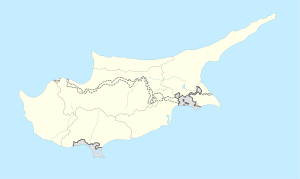
Back بافوس Arabic Pafos Azerbaijani Пафас (Кіпр) Byelorussian Пафас BE-X-OLD Пафос Bulgarian Pafos Breton Pafos BS Pafos Catalan Paphos (kapital sa distrito sa Siyeprus) CEB Pafos Czech
Paphos
| |
|---|---|
Port of Paphos Modern Aphrodite Sculpture Municipal Library Markideio Theatre View of Paphos | |
| Coordinates: 34°46′N 32°25′E / 34.767°N 32.417°E | |
| Country | |
| District | Paphos District |
| Government | |
| • Mayor | Phedonas Phedonos (DISY)[1] |
| Elevation | 75 m (236 ft) |
| Population (2018)[2] | |
| • City | 35,961 |
| • Urban | 63,600 |
| • District | 90,200 |
| Demonym(s) | Pafitis, Baflı |
| Time zone | UTC+2 (EET) |
| • Summer (DST) | UTC+3 (EST) |
| Post code | 8010-8049[3] |
| Area code | +357 26 |
| Major airport(s) | Paphos International Airport |
| Website | pafos |
| Criteria | Cultural: iii, vi |
| Reference | 79 |
| Inscription | 1980 (4th Session) |
| Area | 162.0171 ha |
Paphos (/ˈpæfɒs/ PAF-oss; Greek: Πάφος [ˈpafos]; Turkish: Baf;[4]) is a coastal city in southwest Cyprus and the capital of Paphos District. In classical antiquity, two locations were called Paphos: Old Paphos, today known as Kouklia,[5] and New Paphos.[6] It is the fourth-largest city in the country, after Nicosia, Limassol and Larnaca, with an urban population of 63,600 in 2018.[2]
The current city of Paphos lies on the Mediterranean coast, about 50 km (30 mi) west of Limassol (the biggest port on the island), both of which are connected by the A6 highway. Paphos International Airport is the country's second-largest airport, and is a gateway to western and southern Cyprus. The city has a subtropical-Mediterranean climate, with the mildest temperatures on the island.
In 1980, Paphos was included on the UNESCO World Heritage List for its ancient architecture, mosaics, and ancient religious importance.[7] It was selected as a European Capital of Culture for 2017 along with Aarhus.
- ^ "Phedonas Phedonos".
- ^ a b "Population of Cities in Cyprus (2018)". World population review 2018. Retrieved 19 July 2018.
- ^ "A list of all Cyprus postcodes". cypruspostcodes.eurocyinnovations.com. Retrieved 19 March 2024.
- ^ Peler, Gökçe Yükselen; Arıklı, Güven (2019). Rauf Denktaş ve Fazıl Küçük: I. Uluslararası Kıbrıs Araştırmaları Sempozyumu. Istanbul: Hiperyayın. p. 32. ISBN 9786052815076. Retrieved 9 October 2022.
- ^ Old Paphos, in Ancient Greek: Πάφος παλαιά, Ptol. v. 14. § 1; or, in one word, Παλαίπαφος, Strabo xiv. p. 683; Palaepafos, Plin. v. 31. s. 35)
- ^ New Paphos in Ancient Greek (Πάφος Νέα, Ptol. l. c.; Nea Pafos, Plin. l. c.. The name of Paphos, without any adjunct, is used by poets and writers of prose to denote both Old and New Paphos, but with this distinction, to ancient prose writers it commonly means New Paphos, whilst for the ancient poets it generally signifies Old Paphos, the seat of the cult of the Greek goddess Aphrodite. In inscriptions, also, both towns are called Πάφος. This indiscriminate use sometimes produces ambiguity, especially in the Latin prose authors.
- ^ "Paphos". UNESCO World Heritage Centre. United Nations Educational, Scientific, and Cultural Organization. Retrieved 30 May 2021.









